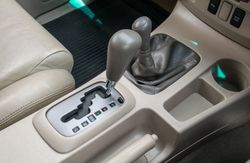A Brief Introduction to Automatic Transmissions

One of the essential components of an automobile is its transmission, the machine that transfers power from the engine to the wheels. Although all drivers have experience with them, few of us understand what they are or how they work. Below is a brief introduction to the function and operation of automatic transmissions.
What Is the Purpose of a Transmission?
The engine of most vehicles lies under the hood. By burning fuel, it creates rotational energy to move a car forward and backward. However, to power the wheels, an additional assembly of machine parts is needed. The transmission not only transmits power from the engine to enable wheel rotation but also adjusts speed and power output. In lower gears, it lets you drive with more power but limits your top speed. In higher gears, it produces less torque but permits faster wheel rotation.
How Does the Transmission Work?
Torque Converter
 A key component of the transmission assembly is the torque converter. Located within a bell-shaped housing, it’s a fluid coupling device that lets drivers engage and disengage the engine from the wheels as they shift between park, drive, neutral, and reverse.
A key component of the transmission assembly is the torque converter. Located within a bell-shaped housing, it’s a fluid coupling device that lets drivers engage and disengage the engine from the wheels as they shift between park, drive, neutral, and reverse.
Planetary Gears
The planetary gear set is a complex mechanism shaped somewhat like a solar system. A "sun" gear sets at the center, and multiple "planet" gears rotate around it. The gears never disengage from the engine, but drivers can adjust their spin by depressing the brake. The spin also adjusts automatically whenever the engine speed becomes too fast or too slow. An automatic transmission shifts up or down as necessary for optimal operation.
If your car is having transmission problems, contact Northgate Transmissions. They are locally owned and have served Greater Cincinnati residents for more than 30 years. Whether you need a flush or a replacement, they can handle the job. Visit their website to learn more about their services, or call (513) 385-4400 to schedule an appointment.
About the Business
(249 reviews)
Have a question? Ask the experts!
Send your question

